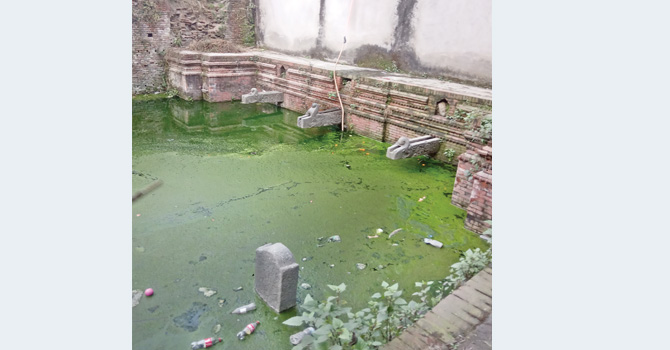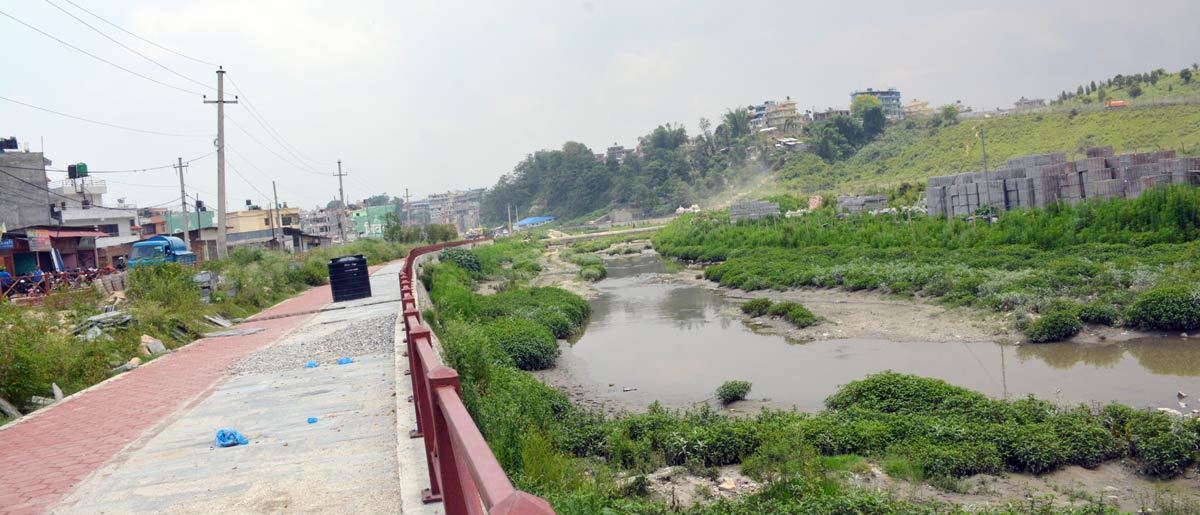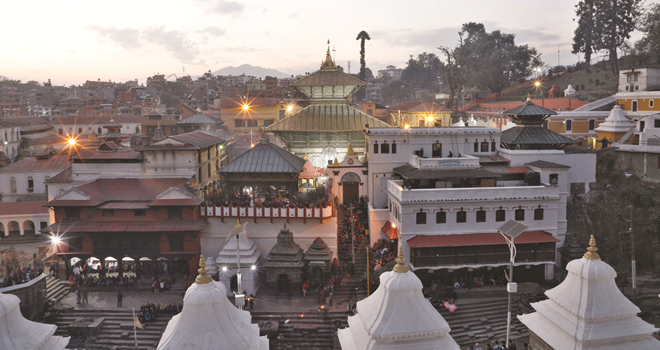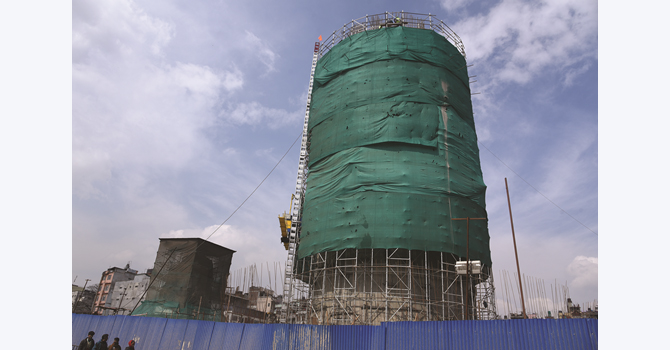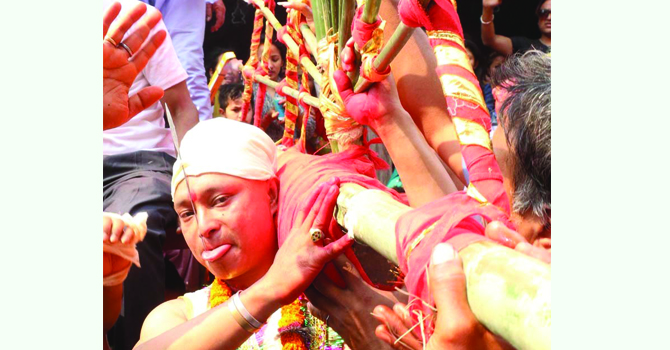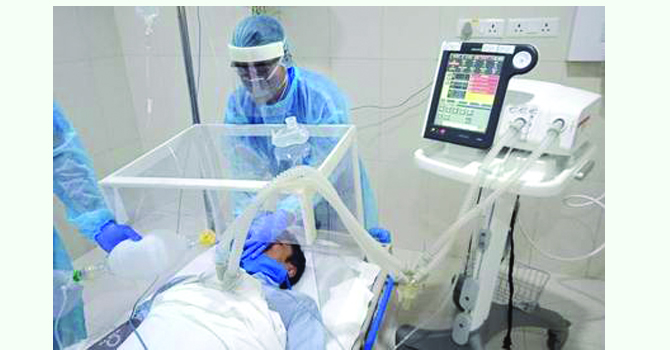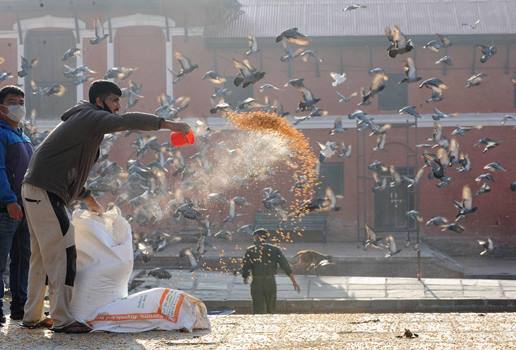Questionable construction mars Swyambhu Stupa’s majesty
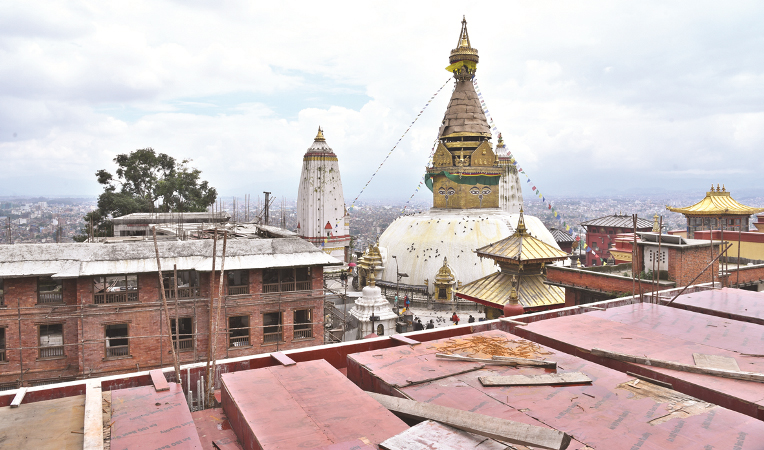
By Binu Shrestha
Kathmandu, Aug. 2: The extensive urbanization and haphazard development are posing a threat to the traditional urban houses of World Heritage Sites of the Kathmandu Valley. The new concrete buildings are often taller than the historic counterparts.
The construction of new urban infrastructure has not only affected most of the monument zones, it has also reduced their aesthetic value with the haphazard construction of multi-storey buildings in their surroundings.
Kathmandu Valley is famous as a traditional cultural hub and for historical sites; shrines and temples are major destinations for tourists and contribute to boost the national economy. Despite this, government authorities have not shown adequate attention towards their conservation, discouraging unplanned urbanization and development.
In recent days, construction of urban infrastructure around Swayambu Mahacaitya zone has been drawing attention of many visitors. The hilltop concrete frame building is being reconstructed by the Karmaraja Mahabhihar while 19 priests’ houses and their shops are under construction phase.
Kathmandu Metropolitan City (KMC) had given authority to demolish the Mahabhihar on 2075-9-1 BS and it passed the design on 2075-6-26 BS. The Department of Archeology (DoA) has permitted to limit its height to 24 feet in three storeys and it passed the design on 2075-6-11 BS. Land Revenue Office has issued the land certificate in the name of Mahabhihar on 2064-6-8 BS.
Bhim Nepal, heritage expert, said that several geological studies over the hilltop of Swayambhunath had recommended removing non-archeological structures on the edge of the hill to prevent landslides.
Risk study conducted by CARD, Institute of Engineering, in 2014 pointed out that uncontrolled extension and addition of new buildings were the cause of landslides at various times.
According to the historical information, risk of landslide became more prominent as soon as the hill was occupied. Therefore, it can be inferred that human activity is one of the main triggers of land instability, the report said.
Swayambhu Conservation Master Plan had basically intended to regain and preserve the character of the hill as religious and natural site in 1989. The plan indicators include the reconstruction of new buildings, demolition of existing ones, reforestation, and water faculties.
Technical Report Swayambhu No Construction Zone study report in 1982 had also recommended keeping new structures away from the edge of the slope.
The dome of Swayambhunath itself weighs heavy, hence the new concrete frame structure in smaller area may invite further landslide. Such structure has resulted in the loss of the aesthetic value of preserved monuments zones and is likely to again keep World Heritage Site (WHS) of Kathmandu Valley in danger list, Nepal added.
In 2003, the Kathmandu Valley was kept in the WHS endangered list. The main reason given by UNESCO was the loss of urban fabric of surrounding zone of the protected monuments.
UNESCO had conducted geological study at the hilltop of Swayambhu Stupa before lockdown. The preliminary report has not indicated any risk of trigger of landslide due to under construction structures of the monument zone. It needs to wait for the final report and views of geological experts over the study, said Dr. Suresh Surash Shrestha, information officer at the Department of Archeology (DoA).
Shrestha said that structures were being erected under the act of private houses. It is not allowed to use other non-traditional materials
in the monument, but such rule may not be applied to privatehouse owner.
The report on the joint World Heritage Center/ICOMOS/ICCROM Reactive Monitoring Mission to the Kathmandu Valley 2017 deals with further landslides and it proposed to reconstruct the monasteries and priest houses on a smaller scale than previously taking into consideration the risks of landslide but it has not mentioned structure model.
The mission also pointed out that new water distribution system was being built throughout the city and planned to run through some of the monument zone threatening the subsurface archaeology.
The proposed Ring Road expansion around Swayambhu is likely to affect some of the monuments within that zone.
Rajendra Lal Manandhar, secretary of Swayambhu Reconstruction and Management Consumer Committee, and Karmaraja Mahabhihar said original height of the monastery has been limited to 24 feet from 36 feet, leaving 8 metres areas on the side of the Stupa. The priest houses have left 2 metres.
The 19 priest housing and Mahabhihar have been contracted under a single project of reconstruction of earthquake damaged buildings of Swayambhu at a cost of over Rs. 130 million which started from 15th February, 2019 and so far 80 per cent work has been completed, he said.
Recent News

Do not make expressions casting dout on election: EC
14 Apr, 2022
CM Bhatta says may New Year 2079 BS inspire positive thinking
14 Apr, 2022
Three new cases, 44 recoveries in 24 hours
14 Apr, 2022
689 climbers of 84 teams so far acquire permits for climbing various peaks this spring season
14 Apr, 2022
How the rising cost of living crisis is impacting Nepal
14 Apr, 2022
US military confirms an interstellar meteor collided with Earth
14 Apr, 2022
Valneva Covid vaccine approved for use in UK
14 Apr, 2022
Chair Prachanda highlights need of unity among Maoist, Communist forces
14 Apr, 2022
Ranbir Kapoor and Alia Bhatt: Bollywood toasts star couple on wedding
14 Apr, 2022
President Bhandari confers decorations (Photo Feature)
14 Apr, 2022


